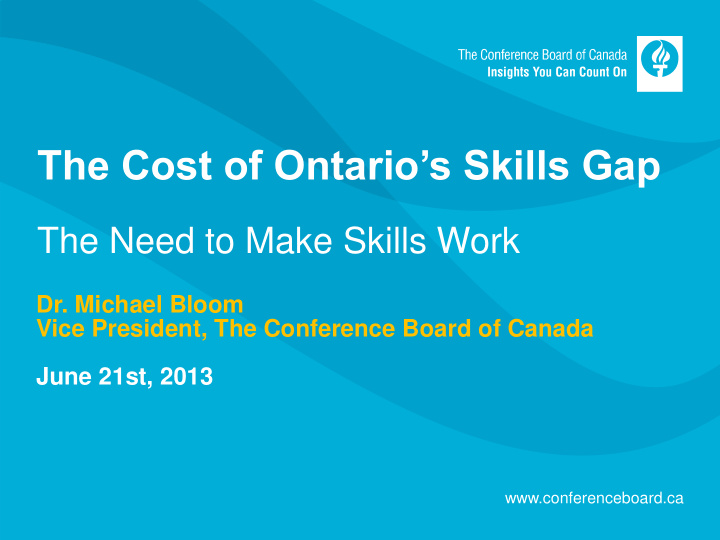



The Cost of Ontario’s Skills Gap The Need to Make Skills Work Dr. Michael Bloom Vice President, The Conference Board of Canada June 21st, 2013 www.conferenceboard.ca www.conferenceboard.ca
Skills Gaps Loom Skills Gaps Threaten Ontario’s Economic Potential • Ontario employers face labour and skills shortages that threaten competitiveness, economic growth, and prosperity. • By 2025, aging and slow population growth could produce a labour shortfall of 364,000 workers. • Employers are already reporting 2 skills shortages. 2
Also Skills Mismatches • But some sectors have labour and skills surpluses — including low- skilled manufacturing, clerical work, and teaching. • Skills mismatches today. • Many Ontarians are not being trained with the right skills for success in today’s economy. 3 3
Skills Protect Employment • Overall, the skilled fare better than the non-skilled. • 81 per cent of jobs lost during the recession were lost by people who lack post-secondary credentials. 4 4
Concerted Effort Required “ A serious and growing skills mismatch is cutting Ontario’s growth and contributing to poverty. Without a concerted effort, Ontario’s unskilled workers will see their opportunities drop even faster, while employers have even more difficulty in attracting and retaining the talent they need.” Ontario’s Workforce Shortage Coalition 5 5
Mismatches Require Action “Unless we adopt proactive policies now, we will face a world in which there will be a lot of people without jobs and simultaneously an even larger number of jobs without people.” Dr. Rick Miner 6 6
Key Questions • What is the size, shape, and impact of the skills gap in Ontario? • What is the cost to the economy? • What occupations, skills, and post- secondary credentials will be required to power economic growth in Ontario? • What actions can be taken by leaders in business, government, and education to develop the skilled labour force we need? 7 7
The Need to Make Skills Work • The Conference Board conducted a study to advance the skills discussion. It involved: • A survey of 1538 Ontario employers . The respondents employ over 760,000 people — 13.5% of the total workforce in the province. • 40 in-depth interviews with employers and labour market experts. • Data analysis to estimate the economic impacts of skills gaps. 8 8
The Cost of Skills Deficits • Between 1990 and 2012, the employment rate for individuals with only “some PSE or less” dropped from 58 to 48 per cent . • The lower employment rates of these less- skilled workers is costing the Ontario economy as much as $24.3 billion annually in forgone GDP. 9 9
The Cost of Skills Deficits • Up to $4.4 billion in additional federal tax revenues and $3.7 billion in provincial tax revenues annually may have been achieved if more people in this cohort of workers had increased their skills. 10 10
The Costs of Skills Mismatches • In addition, many individuals have skills and educational qualifications that are under-utilized in the economy (e.g., “university graduate baristas, taxi drivers”). • The underutilization of skills is costing the province up to $4.1 billion in forgone GDP — that is, if all employees were in jobs/occupations that used all their skills and education fully. 11 11
The Costs of Skill Mismatches • If these skills were fully utilized: • Federal tax revenues would increase by $747 million annually. • Provincial tax revenues would increase by $627 million annually. 12 12
Employer Survey Results Key Findings • Ontario employers are very concerned about skills shortages. • They identify many negative impacts to business performance. • Skills gaps result in lower productivity and lower product/service quality, according to most. 13 13
Changes in Employment To what extent has your company shifted towards a higher skilled workforce over the past decade? 14 14
Higher Skills Trend To what extent does your company expect to shift towards a more skilled workforce over the next decade? 15 15
Level of Employer Concern How concerned are you about the no. of employees with specialized skills retiring in years ahead? 16 16
Fear of Losing Skilled People How concerned are you about losing employees with specialized skills to other employers? 17 17
Performance Impacts Anticipated firm-level impacts of skills gaps 18 18
Skills Employers Seek Which essential skills have you had difficulty finding among recent hires or job candidates? 19 19
PSE Credentials As Ontario’s economy returns to stronger growth, what post-secondary credentials will you be looking for in your new hires? 20 20
Trades Among those who answered “trades”, top priorities are: 21 21
College Credentials Among those who answered “2 or 3 year college diploma”, top priorities are: 22 22
4 Year Degrees Among those who answered “4 year degree”, top priorities are: 23 23
Top 20 Occupations Needed % Employers Needing Occupation 24 24
Employers’ Skills Strategies 76 per cent of employers use at least one kind of experiential learning strategy. These include: 25 25
Barriers to Employer Action Are there any common challenges that explain your lack of use or interest? 26 26
How to Fill the Skills Gap • Ontario urgently needs strategies to address skills gaps. • A highly skilled and engaged workforce is essential to economic prosperity and social well-being. • The Executive Summary (that you received) includes the report’s full recommendations. 27 27
Skills Solutions Employers • Increase investments in training and development and provide more experiential learning opportunities. 28 28
Skills Solutions Students • Learn more about labour market needs/opportunities and align education and training to labour market realities. 29 29
Skills Solutions Educators • Assess and adjust programs and curricula to better reflect current and future labour market realities. 30 30
Skills Solutions Government • Improve labour market information, and allocate additional resources for experiential learning opportunities. 31 31
The Need to Make Skills Work • Report released today. • Available at: www.conferenceboard.ca 32 32
www.conferenceboard.ca
Recommend
More recommend